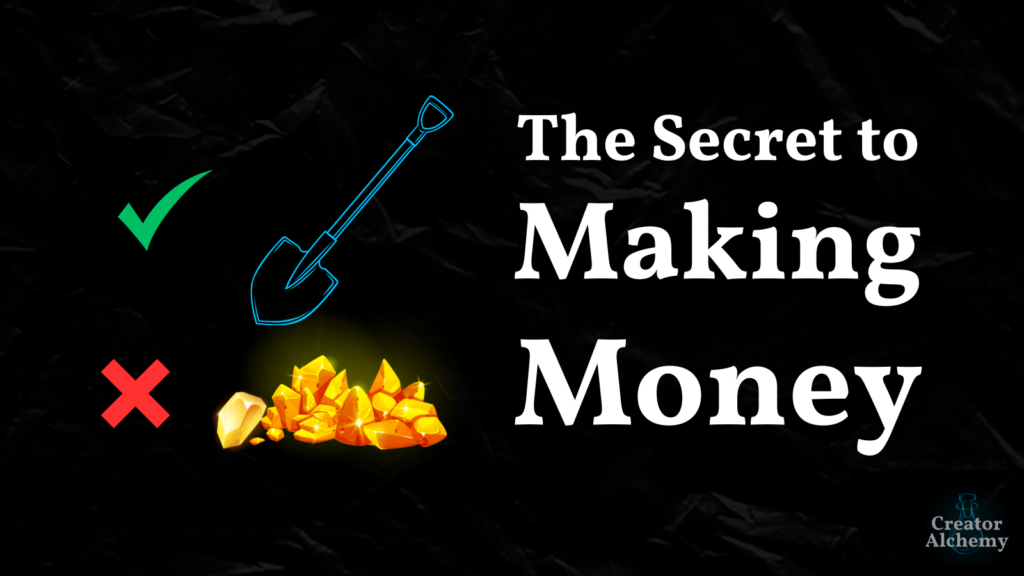Self-promotion is critical to letting people know about your offer.
But it also feels super cringey.
And this cringeyness causes us to avoid sharing our stuff with the world.
So how do we overcome it and share the things we’ve created with our audience?
It comes down to human psychology.
Specifically, the intention behind why we’re doing self-promotion.
And there are 3 main reasons we do it.
Here’s what I mean…
•••
Intention #1: To Flex
Most of the time when we think about self-promotion, we think about flexing:
- Screenshots of Stripe notifications
- Posts about how someone made 6 figures in a week working 2 hours a day
- Pictures of them sipping cocktails and smoking cigars with the bros lounging on the beach
This is super common in entrepreneur/solopreneur circles on the internet—and it’s usually a mid-20s single guy spouting platitudes and selling social media growth guides, ghostwriting services, or some outbound sales agency that will totally help you hit $10K this month.
Flexing is pointless, because there’s no value behind it.
Your audience gains no benefit other than some cheap hits of dopamine a la vicariously living through you and giving you an imaginary fist-bump through the internet.
And unless you’re arrogant and entitled, this kind of self-promotion will 100% feel cringey—and it should feel cringey because it is cringey.
So if this is what you think self-promotion is, of course you’re going to avoid it.
But there’s another common reason self-promotion feels cringey…
•••
Intention #2: To Plead
If we’re not arrogant, and we have insecurities around self-promotion, when we actually do engage in it, it comes across as a desperate plea:
- “Please buy this thing I worked super hard on!”
- “Only 4 hours left to buy this thing I spent hours making!”
- “If you liked this content, please consider supporting me by becoming a patron, it really helps me pay my bills and keep doing this!”
This is common when creators don’t have an entrepreneurial mindset and feel the constant need to beg for money from their audience.
Pleading is less than pointless—it’s outright harmful. Because people will forgive some arrogance here and there, but if you reek of desperation people will actively avoid you.
So yes, pleading feels cringey because it is cringey—for you and everyone involved.
Luckily, there’s a better way to approach self-promotion than flexing or pleading that doesn’t feel cringey…
•••
Intention #3: To Inspire and Help
If you do self-promotion with the intention of inspiring others or letting them know about something you created to help them, you won’t feel cringey (or at least, not as much):
- “I’m proof someone like you can succeed because I am someone like you.”
- “You said you had this problem. Here’s something I made to help you.”
- “Here’s what I learned the hard way, so you don’t have to struggle.”
For example, my article Voices of the Mountains is about how when I was growing up in rural Appalachia, I never saw “successful” people who sounded like me. I thought the only way to be a doctor or entrepreneur was to lose my accent. But over time, I realized this was false and slowly accepted my heritage.
I end the piece by saying:
“So to anyone who thinks you have to lose your accent to make something of yourself, let me introduce myself.
My name’s Corey. I’m a doctor. I’m an entrepreneur. And I’m from up a holler. I say y’all and no one can stop me.
You can be whatever you want, and you can do it with a country twang in your voice.”
The point of this piece was to inspire the next (or current) generation of entrepreneurs to embrace their accents, heritage, and everything else that makes them unique.
But you can also share Stripe notifications or other business wins with the intention of inspiring your audience and proving to them it’s possible. Sharing real examples to help you audience overcome limiting beliefs or sharing lessons with “past you” isn’t cringey because you’re not doing it to flex.
Take this thread by Dakota Robertson. It could be seen as a flex, but his intention is to inspire. So it comes across as more genuine and compelling. Yes, he started with Stripe notifications for social proof, but he goes through his struggles from early childhood through young adulthood and how he ended up building a successful creator business to inspire his audience to do the same.
You can also share that you have a limited-time sale going on if they intention is to help you audience take action and save money. Now, you don’t reek of desperation because you’re genuinely trying to help your audience.
It all comes down to intention.
•••
Final Thoughts
If you believe your offer is valuable, and you believe it would legitimately help your audience—then you have a responsibility to tell them about it. Period.
Otherwise, they might never find out about it and never benefit from it.
And the best way you can help them is to do self-promotion with the intention of inspiring and helping.
It’s not about bragging and it’s not about asking for a handout. It’s about genuinely sharing something you created with the people you created it for.
So the next time you start to feel cringey about self-promotion, ask yourself:
“What is my intention behind sharing this? To flex? To plead? Or to inspire and help?”
If it’s #3, do it and leave the cringe at the door.



